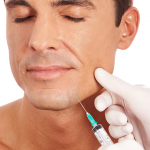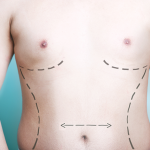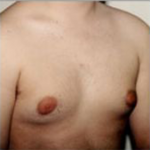MEN & COSMETIC SURGERY
Our society places a high value on looking young and fit. Today, men of all ages and all walks of life are requesting plastic surgery for cosmetic reasons. Men’s goals include a more balanced nose, a rejuvenated face and a trimmer waistline. The procedures used to achieve these goals must take into consideration factors such as skin thickness, beard growth or body type.


Good communication between you and your plastic surgeon is essential when planning your surgery. In your initial consultation, you’ll be asked to explain in detail why you want the procedure and how you hope to look and feel afterward. It’s important to set aside any awkwardness you might feel, and speak candidly about the changes you’d like to see. You should feel completely assured that you and your surgeon understand one another.
Your doctor will also evaluate your health, conduct a physical exam, take preoperative photographs, and explain which surgical techniques are most appropriate for you. You’ll discuss the type of anesthesia to be used, the type of facility where the surgery will be performed, the possible risks, and the costs involved. Medical insurance usually doesn’t cover cosmetic procedures. However, there are medical financing options such as Nova Medical that support funding for surgical procedures.
Tell your surgeon if any part of the consultation makes you uncomfortable, or if you have any special privacy requests. Above all, it’s important to have realistic expectations about your surgery. Remember, your doctor can offer significant improvement, but not perfection. Keep in mind that your age and health may play a role in the quality of the outcome.
Extensive information about the particular procedure you plan to have will be provided during your consultation. While going over the steps of the procedure, your doctor will discuss a number of issues that may influence your surgery. Make sure you fully understand these considerations.
If you are planning facial surgery or neck surgery, your doctor will evaluate your entire head-face-neck region. In general, it’s known that male facial skin has a richer blood supply than female facial skin. Male faces bleed more during surgery and are at greater risk for forming a temporary collection or pooling of blood under the skin, called a hematoma, after surgery.
Hair growth and beard growth may play a major role in the outcome of a facelift. If you are balding or have thinning hair, surgical techniques may be required to hide the facelift incision, especially in the temple area. If the hair bearing skin of your upper neck is pulled behind your ears during surgery, you may find that you must shave behind your ears or the back of your neck. However, sometimes electrolysis can correct this problem. Be sure to discuss these possibilities with your surgeon.
A fatty or “jowly” area beneath the chin is also a concern for many men. In younger patients, liposuction alone may be sufficient to correct the problem. Older patients may require a full facelift and necklift, which may include the removal of excess skin and tightening the platysma muscles, which run down each side of the neck. These muscles are usually thicker in men than they are in women, but do not pose a greater challenge for your plastic surgeon.
Cosmetic procedures such as eyelid surgery, nose surgery and facial-implant surgery are performed essentially the same way for men and women. However, it’s important to let your surgeon know if you are seeking a more masculine look to your facial features – a chin with better projection, more prominent cheekbones, a stronger nose.
The ideal male body shape is considered to be trim and athletic looking, with broad shoulders and chest, a flat abdomen, and a narrow hip-thigh area. However, as men age, areas of fat tend to accumulate around the abdomen, the flanks, breast area and along the chin and neck.
Men sometimes seek liposuction to remove these fatty areas that are resistant to diet and exercise. In many cases, liposuction alone can effectively correct these problem areas. Men retain their skin elasticity longer than women do, and the areas of fat beneath the skin tend to be firmer and more vascular than those in women. Because of these and other factors, liposuction in men is usually very effective.
Men who have some loose, hanging skin as well as areas of excess fat may opt for a traditional excision procedure (surgical skin removal) in addition to liposuction. An excision may also be performed on gynaecomastia patients whose breast enlargement is made up of mostly glandular tissue, rather than fat.
A full abdominoplasty or “tummy tuck” may be chosen by men who have hanging abdominal skin (usually the result of massive weight loss), loose abdominal muscles, and/or neglected hernias. It is a major surgical procedure that removes excess fat, tightens the muscles of the abdominal wall, and trims the waistline. Men who have a full abdominoplasty are often surprised at the long recovery period.
Men with good skin elasticity who have only a moderate amount of excess abdominal fat may benefit from liposuction alone.
The days and weeks immediately following your surgery are critical to obtaining a good final result. Therefore, it’s essential that you follow your post operative instructions including taking adequate time off work, wearing tight compression garments, getting enough rest, staying out of the sun, saying no to alcohol and cigarettes, and avoiding strenuous activity, exercise and sports and sex in the early postoperative period.
GYNAECOMASTIA
Gynaecomastia is a medical term for overly developed male breasts. Male breast reduction surgery removes fat and or glandular tissue from the breasts, and sometimes excess skin for an improved chest contour. For men who feel their breasts are too large, breast reduction surgery can offer a “more masculine” looking chest.

Before*

After*
A much more common condition than most people realize. Gynaecomastia is a medical term for overly developed male breasts. The condition affects an estimated 40 to 60 percent of men and may affect one or both breasts. The cause of the majority of Gynaecomastia cases is unknown, but certain drugs and medical problems have been linked to some. Though the condition is largely cosmetic, it can cause great self-consciousness and emotional upset or reactions in men. For men who feel their breasts are too large, breast reduction surgery can offer a “more masculine” looking chest.
Male breast reduction surgery removes fat and or glandular tissue from the breasts, and sometimes excess skin for an improved chest contour.
Though basic breast reduction information is provided on this website, the best way to get answers to specific questions about your needs is to schedule a consultation.
Men of all ages undergo gynaecomastia correction, though they should be healthy, emotionally stable. Those with fairly good skin elasticity will see the best results. Though teenage boys may benefit from the procedure, they may eventually need a second procedure down the road if the condition persists or recurs.
For obese or overweight men, exercise and a healthy weight loss plan may correct the condition without surgery. It is recommended you attempt to correct the problem through these methods before undergoing male breast reduction. Since alcohol and marijuana use may cause gynaecomastia, as well as the use of steroids and other specific drugs, you may well be asked to stop using these drugs before surgery to see if the condition changes.
Though many men undergo breast reduction surgery each year and experience no major complications, the procedure does carry some degree of risk. It is important you are well informed of these risks when considering male breast reduction. Mr Lofts sees the discussion of potential risks and complications as one of the most important aspects of patient consultation. During your consultation, he will discuss these potential complications with you, and offer instructions on how to minimize your risk.
Risks are similar to those in all surgical procedures and include:
- Injury to the skin
- Excessive bleeding
- Reaction to anesthesia
- Infection
- Accumulation of fluid
It should also be noted that noticeable scarring may occur, as well as changes in skin pigment, temporary sensation loss, and slight asymmetry between the breasts or nipples. Before surgery, these risks should be carefully weighed up with the benefits offered by the procedure.
It is important to follow instructions when preparing for gynaecomastia correction to ensure the best possible results. Those instructions may include:
- Refraining from smoking for several weeks before and after surgery
- Avoiding certain medications
- Avoid alcohol 2-3 days prior to surgery
For more details and information on pre-operative instructions use this link.
Male breast reduction surgery may require a short hospital stay, though most are performed on an outpatient basis, allowing patients to return home the day of surgery.
During surgery, analgesia will be administered to ensure comfort. General anesthesia will most likely be used to allow you to sleep during the procedure.
For breast enlargement composed primarily of excess glandular tissue, the tissue may rarely be removed with a scalpel though curved incisions on the edge of the areola (the dark skin surrounding the nipple). For major reduction procedures, larger incisions may be needed. In most cases however, liposuction will be used to remove any excess fatty tissue as well as the glandular tissue. In these instances, the liposuction cannula will be inserted through a very small incision at the edge of the areola.
Gynaecomastia primarily caused by excessive fatty tissue requires smaller incisions to correct- less than a half-centimeter in length along the edge of the areola or on the breast fold. Through these incisions, Vaser ® liposelection will be performed to remove the fatty tissue using a slim tube called a cannula attached to a vacuum pump to break up and suction out excess breast fat. If a large amount of fat or glandular tissue is removed, excess skin may need to be removed as well to create a firm, flat contour.
At the end of your procedure, a small drain may be inserted to prevent the accumulation of excess fluids. The chest will be wrapped in a compression garment to keep the skin firmly in place.
Your chest will feel sore for a few days after surgery. This discomfort is generally well controlled with pain medications. You will need to have someone drive you home after surgery and to help you out for the first day or two. You will need to wear an elastic pressure garment for the first few weeks to reduce swelling in the chest. Though the swelling will go down greatly during the first few weeks, it may be months before the final results of your surgery emerge.
You will be encouraged to get up and walk around on the day of surgery. Non strenuous work can be resumed within one or two after surgery, though heavy exercise, including sexual activity, should be avoided for several weeks. Any stitches you have will be removed approximately 1 to 2 weeks after surgery. Sports or strenuous employment may need to be avoided for the first four weeks. After the first month, however, most patients are able to resume all of their normal activities.
Gynaecomastia surgery offers a high rate of patient satisfaction to those who go into it with realistic expectations. It can offer dramatic improvement to the contour of your chest creating a flatter, firmer look. The results of the procedure are generally permanent, though occasionally teen boys may need a second procedure later if the gynaecomastia returns.
For further information please read the post operative instructions and if you have further questions my staff or I are available to talk to you should you have any concerns.
